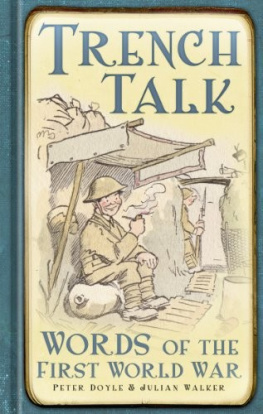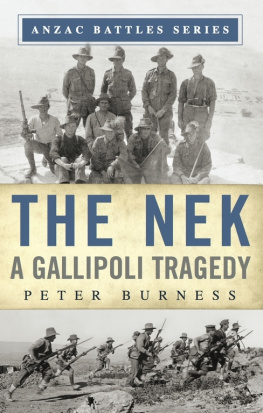
For the forgotten men of Suvla Bay
The letters of Frank and Percy Talley came to me from an antique shop in central London. It has been a privilege to recount the stories of the two men, their lives at home and in action at Gallipoli. I hope this book does them justice. I would like to thank those who have had faith in their story, and who shared my enthusiasm and interest in it.
I am grateful to Glad Stockdale who typed up the letters for me a gargantuan task and to Jo de Vries at The History Press for her unremitting enthusiasm.
I have called upon friends and colleagues for advice and assistance: Chris Foster for his wise counsel, Rob Schfer for his patience (while we worked on another project together), and Paul Reed. Steve Chambers very generously allowed me to use photographs from his personal collection depicting the men of the Middlesex Hussars at Suvla (and the modern vista of Scimitar Hill); these are shown in the picture section. Paul Hewitt from Battlefields Design worked with me on the maps. Julian Walker sourced newspaper references for me, which was very valuable. Hugh Petrie, in the local studies department of Hendon Library, similarly assisted me in a search for obscure newspaper references. The Antiques Storehouse, Portsmouth, kindly supplied the image of the Rough Riders pre-war uniform. In good faith I have endeavoured to seek out copyright holders.
Finally, my biggest thanks are reserved for my greatest supporters, Julie and James.
Contents
A bundled collection of letters which chronicled the wartime histories of two brothers from Muswell Hill, a relatively well-to-do suburb of London, emerged in an antique shop. Frank and Percy Talley, Troopers 2365 and 2366 of the 1st City of London Yeomanry (Rough Riders), were educated middle-class men who volunteered for duty as yeomen, and who experienced what it was like to be soldiers of Britains volunteer cavalry in the early years of the war. It was their destiny to leave the shores of England to take part in the last, and most costly, single-day battle of the Gallipoli Campaign, on 21 August 1915.
In more than 200 previously unpublished and carefully composed letters, the Talley brothers describe their training in England, and their move to the east coast to man the trenches there during the invasion scare of 1914, in the wake of its bombardment by the German Navy.
The letters are from two loving sons to their parents, and have been only lightly edited. They observe the attack of German Zeppelins at Great Yarmouth. They describe the activities of the Rough Riders in preparing for war, of their transportation to Egypt and Suez, and of their expectation that they would be used in action at Gallipoli. Anchored offshore from the peninsula, ultimately they observed the landings there and the First Battle of Krithia in April 1915, and their preparations for action in the near future.
Both brothers were later involved in what was to be the last battle of the Gallipoli Campaign in August; this is their story.
The Battle of Scimitar Hill, at once the largest, the most costly and the least successful of the Gallipoli battles; the days gain a single trench ... the days losses a third of the troops engaged.
A.S. Hamilton MM, The City of London Yeomanry (Roughriders) , 1936.
1
The City of London Yeomanry (CLY) was special. While many volunteer cavalry regiments were created during the Napoleonic Wars, the CLY was raised as part of the Imperial Yeomanry in support of the Empire during the Anglo-Boer War of 18991902. With the war in South Africa demanding new tactics, the mounted infantryman came into his own, and new units were raised to counter the Boer threat.
Originally styled the County of London Yeomanry, very soon the new regiment aligned itself with the City that square mile of financial institutions that was the hub of Empire and adopted the suitably dashing and fashionable designation as Rough Riders (RR), after the style of Theodore Roosevelts volunteer cavalry that had stormed San Juan Hill in Cuba in 1898 during the Spanish-American War. Like many yeomanry regiments, the CLY (RR) soon became a favoured club of City men who had a penchant for equines of officers who liked to ride to hounds in the shires, and of other ranks drawn from the various trades that dealt with horses.
Dazzled by the uniform of purple and slate blue, developed after the style of the lancers with traditional chapska helmet and lancer plastron tunic, others were attracted by the possibilities available on walking out, and the chance of gathering the admiring glances of ladies in parks and on promenades, not to mention their annual parade as part of the Lord Mayors Show through the City of London.
Whatever the attractions, the 1st City of London Yeomanry (Rough Riders) indeed became a force to be reckoned with during the Boer War, when, now clad in cotton khaki drill and cork helmet, the regiment was thrust into action. For this service the CLY was awarded the first of its battle honours, honours that would later be supplemented by others in the Great War gained over a terrain in the Middle East that was not too unlike that first experienced in South Africa.
Following the South African War, the CLY (RR) formed one of the fifty-five yeomanry regiments that would become assimilated into the new Territorial Force created by Viscount Haldane in his reforms of the British Army again in the wake of the experiences of the Boer War, when it was realised that the army would need some significant reorganisation if it ever wanted to fight a large-scale war again. Men of the volunteer, part-time, Territorial Force were designed to be home defence units, but with the arrival of a war that soon spread beyond the confines of Europe in 1914, the part-time yeomen would be asked to take the Imperial Service Commitment that would take them overseas to face Johnny Turk in Egypt and Gallipoli in 1915.
Frank and Percy Talley were brothers destined to serve in the ranks of the Rough Riders. Born within the City of London itself, they worked in its financial institutions as did their father, head of a household that boasted a domestic servant in the fashionable north London suburb of Muswell Hill.
George Talley was of advanced years when his sons went to war. Originally from Portsmouth, for most of his working life he had worked in the City of London, living at its heart in Old Broad Street, just south of London Wall. Both boys were born here. An ancient part of the city, this road had been at the heart of the cutting-edge communications serving the submarine cable industry that had been born in the mid part of the nineteenth century, after the discovery of the value of gutta-percha, a natural rubber material, as an insulating material over a copper core. Laying submarine cables was big business, and by 1914 there were 322,000 nautical miles of cable laid, which enabled telegraphic communications across the globe. This industry meant that George was able to support his large and growing family that would amount to six sons and two daughters. Of these, only Frank and Percy would see service in the First World War.
In 1910, Muswell Hill was a very fashionable suburb of London, the epitome of Edwardian style. Largely constructed between 1896 and 1914, the area was well planned and laid out, meeting the expectations and aspirations of the commercial classes who worked in the bustling centre of the City of London. It was constructed by the builders and developers James Edmondson and William Collins, who, amongst others, were working to take advantage of the sale of large estates to construct their Edwardian show suburb. They built fine rows of Edwardian villas arranged in curving avenues, the area ringed by green open spaces with the attractions of Alexandra Palace built as a pleasure palace on the hilltop to the north.
Next page
















